ASSAULT RIFLES
L1A1 Self Loading Rifle

| Calibre: | 7.62 x 51mm | Muzzle Velocity: | 838m/s |
| Weight: | 4.337kg | Length: | 1.143m |
| Magazine Capacity: | 20 rounds | Rate of Fire: | 40 rounds/min |
| Effective Range: | 600+m | Date in Service: | 1954 |
The United Kingdom developed its own variant of the FN FAL, designating it the L1A1 Self Loading Rifle (SLR). While in production it was manufactured by the Royal Small Arms Factory Enfield, Birmingham Small Arms and the Royal Ordnance Factory. Replacement components were made by Parker Hale Limited. The SLR was fitted with a lug so that it could accept a traditional type of bayonet, and could also fire a rifle grenade. The L1A1 SLR was in service with the British Armed Forces from 1954 until 1987, being replaced by the L85A1.
FN FAL

The most prominent change from the original FAL, was that the L1A1 did not have a fully automatic option.
Other changes included the introduction of a fold-flat cocking handle, an enclosed flash suppressor and a folding rear sight.
Later production SLRs were produced with synthetic handguards, such as the pistol grip, forward hand grip,
carry-handle and buttstock. The synthetic material was produced from Maranyl pastic, a nylon/fiberglass composite.
The standard magazine for the SLR is a 20 round box magazine, the magazine from the 7.62 mm L4 light machine gun was able
to fit the L1A1 SLR, but there are reliability concerns as the L4s system was designed for gravity assisted downwards
feeding, not upward feeding.
L1A1 SLR with IWS
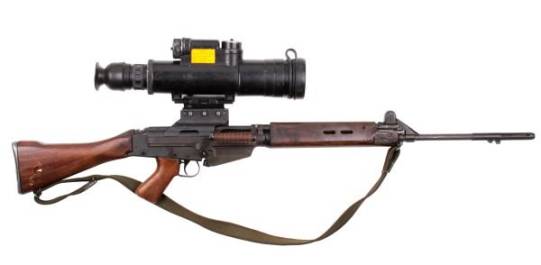
The L1A1 Self Loading Rifle was also adopted by the Armed Forces of both Australia & New Zealand.
The British L1A1's serial number format was:
Country, Manufacturer, Year, Serial number.
UE62A10001 :United Kingdom, Enfield, 1962. Serial A10001.
UB64A10001 :United Kingdom, BSA, 1964. Serial A10001.
UT69A10001 :United Kingdom, Theale, 1969. Serial A10001.
Australian and New Zealand L1A1's use a similar serial format:
AD6210001 : Australian Defence, 1962, Serial 10001
These rifles, commonly called "Lithgows" (as most Australian SLR's were produced at the Lithgow Small Arms Factory), were manufactured in Australia. The various Australian Defence companies (Lithgow SAF,
Mulwalla Powder Factory, Footscray Ammunition Factory, etc) were amalgamated to become Australian Defence Industries. The first
production Lithgow L1A1 was made
in February 1959 (AD5900001) although a small number of production prototypes were completed in late 1958. 1962 was a busy
year which saw 25,500 L1A1's produced by Lithgow, the highest number in any year. New Zealand received 500 rifles in 1959, and then
many more larger shipments over the next few years.
The configuration of flash eliminators, fore grips and butts for the L1A1 is quite diverse, and are contrasted in the
pictures below:
Flash Eliminators
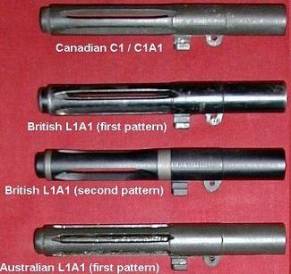
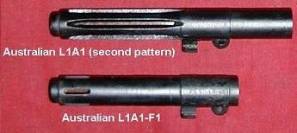
Fore grips
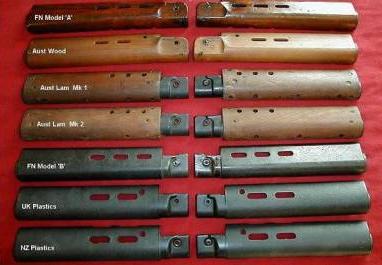
Butts
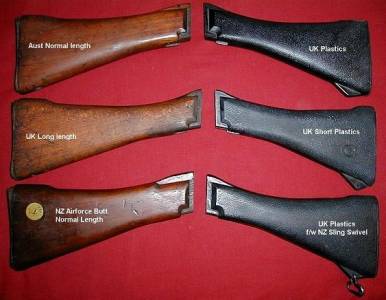
Issued as part of basic issue, the cleaning kit for the SLR contains: SLR Combination Tool, Nylon brush, Wire brush, Pull-through and Oil bottle with applicator.
Cleaning Kit SLR (2nd Issue) circa 1978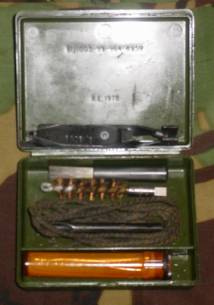 |
SLR Combination Tool circa 1984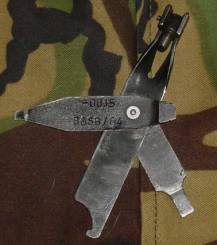 |
M16A1 Assault Rifle

| Calibre: | 5.56mm | Muzzle Velocity: | 975m/s |
| Weight: | 2.89kg | Length: | 0.986m |
| Magazine Capacity: | 20 rounds | Rate of Fire: | cyclic 650 rounds/min |
| Effective Range: | 550m | Date in Service: | 1967 |
Although Airborne forces, the Special Air Service, and soldiers operating in jungle areas used the standard British rifle, the L1A1 SLR, a need for a lighter, shorter, assault rifle with automatic fire capability was identified. The American-made M16A1 was soon adopted. The M16 is a lightweight, 5.56 mm, air-cooled, gas-operated, magazine-fed assault rifle, with a rotating bolt, actuated by direct impingement gas operation. The rifle is made of steel, aluminum, composite plastics and polymer materials. It's 5.56x45mm round had neither the range or stopping power of the 7.62x51mm rounds fired by the SLR, but many more rounds could be carried by one soldier. For these soldiers, who need to carry everything with them, this was a vital selling point.
AR15 Assault Rifle

After some intial teething problems with the early model AR-15 in Aden, the Special Air Service adopted the M16A1 which
became the defacto assault rifle for special operations. The M16A1 went into service in 1967 and is still in service
today with some operational units. The British Army has a Gurkha Battalion stationed in Brunei, where it can maintain jungle
skills.
M16A2 Assault Rifle with M203 Grenade Launcher

British Army and Royal Marine units routinely attend courses and training, where specialised training with the M16
is given at Jungle Warfare School. The M16 has also seen service in Northern Ireland and the Falklands with the British Army.
L85A2 SA 80 Assault Rifle
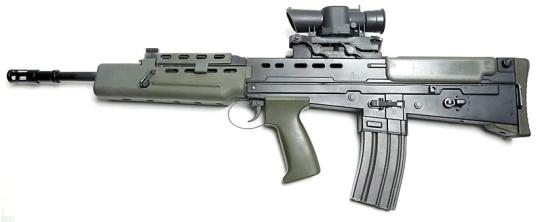
| Calibre: | 5.56mm | Muzzle Velocity: | 940m/s |
| Weight: | 3.82kg | Length: | 0.785m |
| Magazine Capacity: | 30 rounds | Rate of Fire: | cyclic 775 rounds/min |
| Effective Range: | 600m | Date in Service: | 1985 |
The SA80 (Small Arms for the 1980’s) is a British family of 5.56mm small arms. It is a selective fire, gas-operated assault rifle.
Elements of its design, in particular the bullpup configuration, come from the earlier EM-2 rifle. The first prototypes were trialled in 1976 and
production ended in 1994. It is due to remain in service until 2025.
The L85 rifle variant of the SA80 family has been the standard issue service rifle of the British Armed Forces since 1987, replacing the L1A1 variant
of the FN FAL. The improved L85A2 remains in service today. The remainder of the family comprises the L86 Light Support Weapon, the short-barrelled L22
carbine and the L98 Cadet rifle.
The SA80 was the last in a long line of British weapons (including the Lee-Enfield family) to come from the National Arms Development and Production
Facility at Enfield Lock.
L85A2
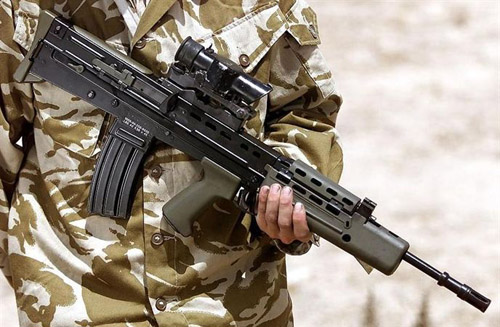
In 1969, the Enfield factory began work on a brand new family of weapons, chambered in a newly designed British 4.85x49mm intermediate cartridge.
While the experimental weapon family was very different from the EM-2 in internal design and construction methods, its bullpup configuration with an
optical sight was a clear influence on the design of what was to become the SA80. The system was to be composed of two weapons: an individual rifle,
the XL64E5 rifle and a light support weapon known as the XL65E4 light machine gun.
The sheet metal construction, and the design of the bolt, bolt carrier, guide rods, gas system and the weapon's disassembly showed strong similarities
to the Armalite AR-18 which was manufactured under licence from 1975 to 1983 by the Sterling Armaments Company of Dagenham, Essex, and which had been
tested by the UK MoD in 1966 and 1969. During the development of the SA-80 a bullpup conversion was made of an AR-18 and a Stoner 63 at Enfield.
Technically in the mid-1970’s the 4.85x49mm round was seen as superior to the then existing version of 5.56mm M193 round in use by the US (for the M16/M16A1)
and by other forces. (This was the expressed view of trials team members whilst demonstrating the XL64E5 prototype at the British Army School of Infantry
at Warminster.) It should be noted that development of small-arms munitions have a long and continuous life and it was estimated by the trials specialists
from Enfield that this weapon would ultimately be superior in the 4.85mm configuration. For the 4.85mm round, both propellant and projectile were at the
beginning of their respective development curves. Also, weight for weight, more rounds of ammunition could be carried by an individual soldier – a
considerable advantage on the battlefield. It was regarded as probable at the time that the argument for the 5.56mm standard within NATO had more to do
with the economics involved. Over the lifetime of a small-arms weapon type far more money is spent on the munitions than the weapons themselves. If the
5.56mm supporters had lost the argument in favour of a British 4.85mm round, the economic impact would have been very large and political pressure
undoubtedly played a part in the final decision.
In 1976, the prototypes were ready to undergo trials. However, after NATO's decision to standardise ammunition among its members, Enfield engineers
re-chambered the rifles to the American 5.56x45mm M193 cartridge. The newly redesigned 5.56mm version of the XL64E5 became known as the XL70E3.
The left-handed XL68 was also re-chambered in 5.56x45mm as the XL78. The 5.56mm light support weapon variant, the XL73E3, developed from the XL65E4,
was noted for the full length receiver extension with the bipod under the muzzle now indicative of the type.
SA80 development was complicated from the start. One complication was at least three project staffing changes at the Royal Small Arms Factory.
This resulted in repetition of testing several times. One problem with the design of the gun itself was cases would be ejected at constantly varying
angles as it heated up and the rate of fire changed, resulting in a large ejection port. The conversion from 4.85mm to 5.56mm also caused a complication,
as the rate of fire dropped dramatically as the gas port was left in the same position but the pressure and time curve of the rounds were different.
The 4.85mm round was based on the 5.56mm case in anticipation of the need to convert calibres. The barrel was changed easily, but the gas ports had to
be enlarged considerably. This was made worse by the production of ammunition with power that gave a lower port pressure and rate-of-fire. Pressure
problems had less of an effect on the LSW due to its longer barrel.
After receiving feedback from users and incorporating the several design changes requested, including adapting the rifle for use with the heavier
Belgian SS109 version of the 5.56x45mm round and improving reliability, the weapon system was accepted into service with the British Army in 1985 as
the SA80. The SA80 family originally consisted of the L85A1 IW (Individual Weapon) and the L86A1 LSW (Light Support Weapon). The first rifle was
issued on 2 October 1985 to Sergeant Gary Gavin, a 26-year-old in the Worcestershire and Sherwood Foresters.
The SA80 family was designed and produced (until 1988) by the Royal Small Arms Factory at Enfield Lock. In 1988 production of the rifle was transferred
to the Royal Ordnance's Nottingham Small Arms Facility (later British Aerospace, Royal Ordnance; now BAE Systems Land Systems Munitions).
In 1994 production was officially completed. More than 350,000 L85A1 rifles and L86A1 light machine guns had been manufactured for the United Kingdom.
Rifles used by the Royal Marines, British Army infantry soldiers (and other soldiers with a dismounted close combat role) and the RAF Regiment are
equipped with a SUSAT (Sight Unit Small Arms, Trilux) optical sight, with a fixed 4x magnification and an illuminated aiming pointer powered by a
variable tritium light source (as of 2006 almost all British Army personnel deployed on operations have been issued SUSATs). Mounted on the SUSAT's
one-piece, pressure die-cast aluminium body are a set of back-up iron sights that consist of a front blade and small rear aperture. Rifles used with
other branches of the armed forces when not on operations are configured with fixed iron sights, consisting of a flip rear aperture housed inside the
carrying handle and a forward post vertical blade foresight, installed on a bracket above the gas block. The rear sight can be adjusted for windage,
and the foresight—elevation. In place of the SUSAT a passive night vision CWS scope can be used, and also—independent of the SUSAT—a laser pointer.
Weapons used by some Royal Marines, Infantry, Ministry of Defence Police and other soldiers with a dismounted close combat role in operations in
Afghanistan have had the SUSAT replaced with the Trijicon Advanced Combat Optical Gunsight (ACOG).
In 2011 the Ministry of Defence began issuing ELCAN SpecterOS 4x Lightweight Day Sights (LDS) in an effort to replace aging SUSAT units across the
British Armed Forces, forming the first stage of the FIST infantry enhancement project. In order to mount the new sight, the weapon has been provided
with an adapter to convert the existing sight rail to the Picatinny standard, in keeping with the updated handguard.
The FIST project has also seen upgrades to the existing Qioptiq CWS (4x) and Maxi-Kite (6x) night vision scopes, and the introduction of the FIST Thermal
Sight, following operational experience with the VIPIR-2+ thermal weapon sight in Afghanistan. All of the new FIST weapon sights have the capacity to
accept Shield's Close Quarter Battlesight reflex sight.
There are 4 main variants that make up the SA80 'family': the L85 IW Rifle, the L86 Light Support Weapon, the L22 Carbine and the L98 Cadet rifle.
The family has currently undergone two major models, LxxA1 being the first issue weapons, and the LxxA2 to distinguish weapons which have undergone
H&K upgrades. The 'L' designation is for "Land Service".
1) The L85 IW ("Individual Weapon") (full name Rifle, 5.56 mm, L85A2), in its improved A2 version, is the standard rifle for the British armed forces.
On operations the rifle is often fitted with a LLM01 Laser Light Module. The L85A2 can also mount the L123A2 UGL 40mm underbarrel grenade launcher.
The addition of the underbarrel grenade launcher adds another 3.30 lb (1.49 kg) to the L85A2's weight.
2) The L86A1 LSW ("Light Support Weapon") is a magazine-fed automatic weapon originally intended to provide fire support at a fireteam level. It has a
longer barrel than the L85A1 rifle and a bipod, shoulder strap and rear pistol grip, together with a shorter handguard. The extended barrel provides an
increased muzzle velocity and further stabilizes the bullet, giving a greater effective range. The weapon is otherwise identical to the L85 version on
which it is based, and the same 30-rd magazines (60 round magazines also being available) and sighting systems are used. Like the L85 rifle, it has a
rate-of-fire selector on the left side behind the magazine housing, enabling either single shots or automatic fire.
The increased barrel length, bipod and the optical performance of the SUSAT give the weapon excellent accuracy. From its inception, the L86 was a
target of criticism on much the same basis as the L85. The LSW has the additional issue (shared by any light support weapon derived from a rifle, for
example the heavy-barrel FN FAL) of its inability to deliver sustained automatic fire as it does not have a quick-change barrel, and is not belt fed.
For a time the primary use of the LSW has shifted to that of a marksman's weapon within many infantry sections, capable of providing precision fire at
ranges of over 600m., however it was replaced in this role by the Rifle, 7.62mm L129A1 The role of a light support weapon is instead filled with the
L110A2 Light Machine Gun FN Minimi which is a belt fed weapon with a quick-change barrel. The L86A1 was upgraded to the L86A2 at the same time as L85A1
rifles were upgraded to L85A2 standards, undergoing the same set of modifications.
3) L22A1 Carbine. There have been three attempts at a carbine, the first was in 1989 (length overall 556mm, barrel length 289mm). The second attempt was
in 1994, this used the standard L86 LSW handguard and a 17.4 inch barrel (length overall 709mm, barrel length 442mm). The third attempt (2003–2004) is
also the only one to officially be adopted - the L22. This resembles the '89 model but has all the necessary A2 upgrades, it has a 318mm (12.5") barrel
and an overall length of 585mm. Around 1,500 were "manufactured" from surplus L86 LSW's, more were built with the increased demand. Due to the shortened
barrel (12.5"), it is less accurate and less powerful, especially at long ranges. Because there is no handguard, these guns are outfitted with a vertical
front grip. (Exists in A1 and A2 variants). Initially issued to tank and armoured vehicle crews for emergency action out of vehicle, the L22 has been seen
in the hands of the Royal Marines Fleet Protection Group and helicopter pilots due to the compact size.
4) The L98A1 Cadet GP Rifle was a general purpose (GP) rifle used by the Combined Cadet Force and Sea, Marine, Army and Air Cadets in the United Kingdom.
It was introduced in 1987 replacing the .303 Lee Enfield No 4 rifles and .303 Bren guns used for weapons training. The L98A1 rifle began a phased
decommission in early 2009 and is now no longer in use. UK cadet forces have now received the updated L98A2 rifles. The L98A1 was similar to the L85A1,
but lacked the gas components. It was a manually operated, single-shot rifle, with a cocking handle extension piece mounted on the right side of the
weapon, and was cocked with the right hand. It was also fitted with adjustable iron sights.
There was a Drill Purpose (DP) version of the L98A1, known as the L103A1. It was similar to the 'GP' rifle, however, modifications had been made in order
to deactivate it: the barrel was sealed by filling it with lead, the firing pin was cut and welded down to the bolt face and the hammer was filed down,
making reactivation uneconomical. The weapons were used by cadets for weapons training. The 'DP' could be identified by a white stripe on the hand guard
and near the butt of the weapon with the letters 'DP' in the stripe. The bolt carrier assembly was painted red and this can be seen from the breech on the
right hand side of the weapon.